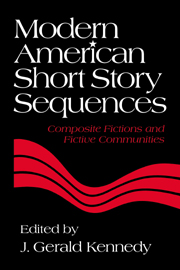Book contents
- Frontmatter
- Contents
- Contributors
- Introduction: The American Short Story Sequence – Definitions and Implications
- Henry James's Incipient Poetics of the Short Story Sequence: The Finer Grain (1910)
- Toomer's Cane as Narrative Sequence
- Hemingway's In Our Time: The Biography of a Book
- Wright Writing Reading: Narrative Strategies in Uncle Tom's Children
- The African-American Voice in Faulkner's Go Down, Moses
- Meditations on Nonpresence: Re-visioning the Short Story in Eudora Welty's The Wide Net
- Nine Stories: J. D. Salinger's Linked Mysteries
- Cheever's Shady Hill: A Suburban Sequence
- John Updike's Olinger Stories: New Light Among the Shadows
- Louise Erdrich's Love Medicine: Narrative Communities and the Short Story Sequence
- From Anderson's Winesburg to Carver's Cathedral: The Short Story Sequence and the Semblance of Community
- Index
Introduction: The American Short Story Sequence – Definitions and Implications
Published online by Cambridge University Press: 29 September 2009
- Frontmatter
- Contents
- Contributors
- Introduction: The American Short Story Sequence – Definitions and Implications
- Henry James's Incipient Poetics of the Short Story Sequence: The Finer Grain (1910)
- Toomer's Cane as Narrative Sequence
- Hemingway's In Our Time: The Biography of a Book
- Wright Writing Reading: Narrative Strategies in Uncle Tom's Children
- The African-American Voice in Faulkner's Go Down, Moses
- Meditations on Nonpresence: Re-visioning the Short Story in Eudora Welty's The Wide Net
- Nine Stories: J. D. Salinger's Linked Mysteries
- Cheever's Shady Hill: A Suburban Sequence
- John Updike's Olinger Stories: New Light Among the Shadows
- Louise Erdrich's Love Medicine: Narrative Communities and the Short Story Sequence
- From Anderson's Winesburg to Carver's Cathedral: The Short Story Sequence and the Semblance of Community
- Index
Summary
A literary form at once ancient and avant-garde, the story sequence resists precise definition and occupies an odd, ambiguous place between the short story and the novel. Critics still disagree about what to call it: The genre discussed here as the sequence – to emphasize its progressive unfolding and cumulative effects – has been variously labeled the “short story cycle,” the “short story composite,” and the “rovelle” (a fusion of roman and nouvelle). Although such works as Joyce's Dubliners and Anderson's Winesburg, Ohio epitomize the type and herald a remarkable outpouring of such collections in the twentieth century, the combining of stories to create a linked series dates back from The Thousand and One Arabian Nights to Chaucer and Boccaccio and even further to classical antiquity itself. Yet efforts to trace the history of the form at once confront the stark discontinuity of its development. Lacunae of centuries between identifiable story sequences call into question the very notion of a sustained tradition. Meanwhile inquiries into its poetics raise a number of difficult questions: What features of arrangement and emphasis differentiate the sequence from the miscellaneous collection? What measure of coherence must a volume of stories possess to form a sequence? In the twentieth century, what distinguishes a connected set of stories from the multifaceted modern novel? Such questions suggest the complications that beset our understanding of what the story sequence is and how it works.
Readers conversant with twentieth-century fiction will, however, instantly recognize the ubiquity and importance of the form as represented by several collections from the era of high modernism.
- Type
- Chapter
- Information
- Modern American Short Story SequencesComposite Fictions and Fictive Communities, pp. vii - xviPublisher: Cambridge University PressPrint publication year: 1995
- 5
- Cited by



